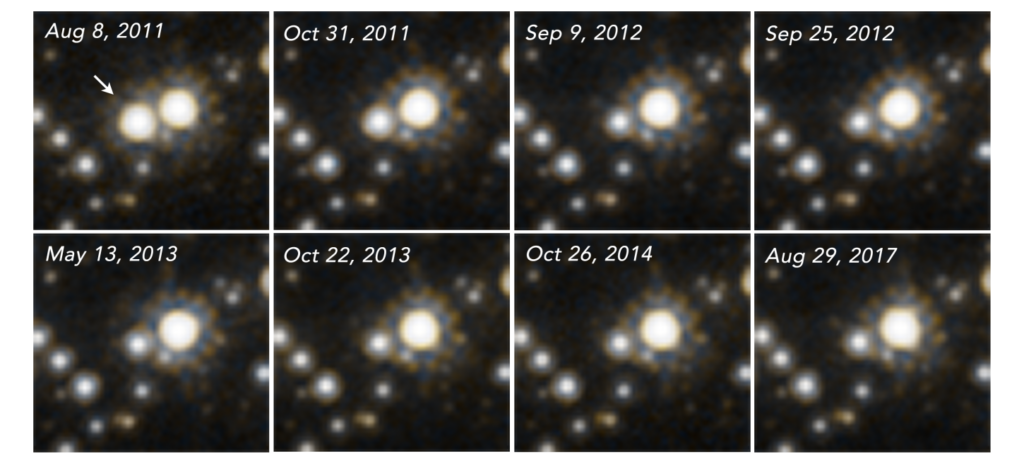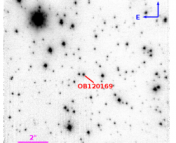Title: An Isolated Stellar-Mass Black Hole Detected Through Astrometric Microlensing
Authors: Kailash C. Sahu, Jay Anderson, Stefano Casertano et al.
First Author’s Institution: Space Telescope Science Institute, Baltimore, USA
Status: submitted to ApJ

Credits: NASA/ESA
I spy with my little eye…
Finding black holes is tricky since, well, they are black holes. This means they emit no light and are basically invisible across the electromagnetic spectrum.
We can only observe black holes indirectly, by the gravitational effects that they have on other objects and matter in the Universe.
The first direct image ever taken of a black hole (BH) is of the one at the center of the galaxy M87. This supermassive BH itself is nothing but a dark shadow at the center of the image, but we see the emission of the hot gas which is swirling around it.
Today’s paper announces the unambiguous detection and mass measurement of an isolated stellar mass black hole. This means, they found a black hole which is not supermassive (a million to a billion times the mass of the Sun) like the ones generally found in galactic centers, but most likely is the remnant of a single massive (> 20 solar masses) star, which reached the end of its life and collapsed into a black hole.
Sometimes these massive stars have companion stars, which live longer and still remain detectable after the collapse of the massive star into a BH. These companions allow us to indirectly detect the BH through their radial velocity measurements, for example. Additionally, binary black holes have also recently been discovered by their gravitational waves.
Subtle Loners
However, finding isolated black holes poses a bigger challenge. The authors of today’s paper note that around 30% of all massive stars are located in single systems, so without a companion.
Aside from the missing counterpart which could offer a way of detecting the BH, isolated stellar mass BHs have accretion rates which are most likely too low to result in visible glowing accretion disks around them, unlike the one around the black hole at the center of M87.
The object discussed in today’s paper was found by a microlensing event called MOA-2011-BLG-191/OGLE-2011-BLG-0462. A bright source passed behind this most likely isolated stellar mass black hole, which acted as a lens, magnifying the source and shifting its astrometric position for the duration of the event, due to the relativistic deflection predicted by Einstein in his General Relativity.
This method is the only viable way to actually find isolated stellar mass black holes.
OGLE and MOA are microlensing surveying programs, constantly observing space since microlensing events are generally not predictable beforehand.
Gravitational Lensing
Such an event can tell observers a lot about the nature of the lens and source. One of the most important properties when it comes to gravitational lensing is the so-called Einstein radius ΘE, which is the angle between the image of the source from the actual source location. The duration of a lensing event is dependent on the ratio between the Einstein radius and the relative proper motion between the lens and the source. Therefore, a long duration event with no detectable light coming from the lens might be caused by a high-mass black hole with a large Einstein radius, but instead, the lens could also be a very faint star with unusually slow proper motion relative to the background source. Thus, it is vital to break this degeneracy by taking very high precision measurements of not only the lightcurve of the event and the spectrum of the source star (in order to determine its distance), but also of the astrometric shift of the source image during the event.
The mass of the lens can then be calculated with the values for the parallax and the Einstein radius.
Patience
The search for isolated stellar mass black holes began in 2009, when the authors went hunting for microlensing events lasting longer than 200 days and with no detectable light coming from the lens in the direction of the galactic bulge.
On June 2nd 2011, the OGLE and MOA surveys simultaneously reported the microlensing event discussed here and, which was observed very close to the extremely crowded galactic bulge, only separated from the galactic center by about 2°.
The observation of the event was strongly diluted by bright neighboring stars, whose light contributions had to be disentangled from the actual magnification of the source by the lensing event. After this, an extremely high magnification factor of around 400 was concluded.
It is necessary to observe the target for a very long time in order to discern the astrometric shifts from the microlensing event from those caused by the proper motion of the source. Thus, the authors continued their observations of the target for six years.
Of course, the shifts are tiny. You need a really good telescope to measure such small changes in position. Luckily, we have one of those in orbit: the Hubble Space Telescope (HST). It is capable of measuring shifts down to ~0.2 microarcseconds. This precision proved sufficient for this particular event with expected astrometric shifts of a few milliarcseconds.

Source: Figure 4 in today’s paper
Figure 1 shows cutouts of the HST observations of the event over the six years. While the magnification only lasts a short amount of the time, the astrometric shift of the source was detectable until the seventh epoch in late 2013.

Source: Figure 13 in today’s paper
The microlensing event was not only observed by Hubble but also by several observatories on the ground. The results can be seen in Figure 2, which shows the full lightcurve (over a time period of 300 days) in the first panel and a zoom-in of the peak in the second panel. It is evident that a lot of data around this event has been collected which contributes to a very confident prediction of its properties.
A lonely stellar remnant
After collecting data for years, the authors come to the conclusion that the lens in the event known as MOA-2011-BLG-191/OGLE-2011-BLG-0462 has a mass of 7.1 +/- 1.3 solar masses and can thus not be a single neutron star or white dwarf, since those would be less massive. The measurements resulted in a lens distance of 1.58 +/-0.18 kpc. Thus, a main-sequence star of this mass and at that distance would have an apparent I-band magnitude of 9.5. Even when accounting for the extinction by dust, it would still be detectable as a light source. Since there is no detectable light from the lens in this case, a regular star can be ruled out as well.
As for the questions whether this lens is a single, isolated black hole or a binary, one must take into account the fact that a binary system acting as a lens strongly affects the photometric and astrometric signatures of the lensing event (as for example lenses do, which are made up of a star with a planet).
Even if the binary black holes would be very close together, the resulting lightcurve and astrometric shift would look different than what is observed.
This is one of the great advantages of gravitational lensing: if one can measure its effects precisely, it gives very detailed information about the nature of the lensing system, even if it is very far away.
So, it appears the authors have actually found a stellar mass isolated black hole by measuring the effects it has on space, which in theory were predicted long ago by Albert Einstein. We have used gravitational lensing as a means to an end many times before, e.g. to detect exoplanets. It is an excellent tool to discover the hidden secrets of our galaxy and beyond.
Black holes arguably remain the most fascinating and extreme objects in the Universe. Being able to pinpoint the location of one of these invisible giants is an extremely satisfying and impressive leap in their exploration.
Astrobite edited by Pratik Gandhi
Image Credits: Today’s paper, NASA/ESA





This article was very helpful in connecting a lot of dots for me on microlensing and detecting black holes. Would new images from the JWST be helpful in discovering more black holes like this?
Hi Madison, thanks a lot for the feedback! Yes, I assume JWST will help us peak even farther into the Universe and pick up microlensing events, since it is very sensitive (about 100 times more sensitive than Hubble!) and due to its infrared capabilities is able to peak into dust and gas clouds, previously opaque to us.
Hello, I was wondering if there have been any triple black hole systems and if so, what methods would you think to use to detect them, would gravitational lensing still work?
Hi Colby, great question! Check out this article: https://astronomy.com/news/2014/06/trio-of-supermassive-black-holes-shakes-space-time, they actually did find a triple system of supermassive black holes! In this particular case, the system was found and observed via Very Long Baseline Interferometry (VBLI), so through radio astronomy. This is possible for very large black holes, like these three or the one at the center of M87. Gravitational Lensing would definitely be able to pick up on triple stellar mass black holes, if the line of sight is right. We can even discern if stars, which lens a background object, have a planet or not in a lot of cases.
What would happen if both of the black holes would collide in the binary black hole system?
Hi James! Well, this is basically how supermassive black holes are believed to come into existence (among other factors, such as accretion). Black holes colliding and merging into another is one of the events producing gravitational waves, which can be measured for example by LIGO.
Do you know of any future devices that could more streamline the discovery of black holes that are currently being developed?
Hello Harrison, that’s a good question. I must say, I am currently not aware of future devices in this area. Gravitational microlensing is, as far as I know, the only viable method to detect isolated stellar mass black holes. There are several surveys, such as MOA or UKIRT and I am sure more will follow in the future, conducted from established ground-based as well as space telescopes.
How did they calculate the 2 degree separation from the crowded galactic bulge and the galactic center?
While reading this and other findings on this, I found that Dr. Casey Lam measured the mass of this object to be lower than 7 Solar Mass. Is there a reason for this to be different even though they both used the microlensing technique? Since the mass is measured to be smaller by Dr.Lam could it also be a neutron star?
Hello,
Thank you for an informative and easy-to-comprehend article.
I would like to ask on why it took us until recently to be able to take a picture of a black hole that has an accretion disk around? Was it because it’s difficult to find black holes with accretion disks? Or was it mainly due to the dust and matter between us and the black hole?
Excuse my question if it has an obvious answer.
Thank you!